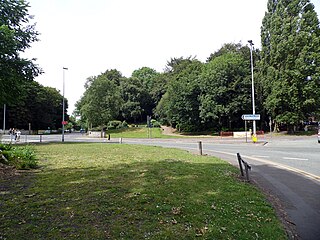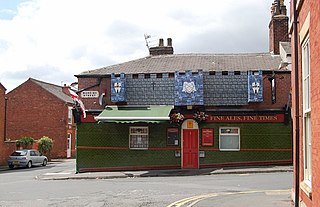
Leigh is a town in the Metropolitan Borough of Wigan, Greater Manchester, England, on low-lying land northwest of Chat Moss.

The Metropolitan Borough of Wigan is a metropolitan borough of Greater Manchester, in North West England. It is named after the main settlement of Wigan but covers a far larger area, extending up to 9 miles eastwards, including the towns of Atherton, Ashton-in-Makerfield, Golborne, Hindley, Ince-in-Makerfield, Leigh and Tyldesley. The borough also covers the villages and suburbs of Abram, Aspull, Astley, Bryn, Hindley Green, Lowton, Mosley Common, Orrell, Pemberton, Shevington, Standish, Winstanley and Worsley Mesnes. The borough is also the second-most populous district in Greater Manchester.
The Ashton, Stalybridge and Liverpool Junction Railway was opened in 1846 to connect the industrial town of Ashton-under-Lyne to the developing railway network, and in particular to the port of Liverpool. It was a short line, joining the Manchester and Leeds Railway at Miles Platting and the connection to Liverpool was over that line and the Liverpool and Manchester Railway.
The Bolton and Leigh Railway (B&LR) was the first public railway in Lancashire, it opened for goods on 1 August 1828 preceding the Liverpool and Manchester Railway (L&MR) by two years. Passengers were carried from 1831. The railway operated independently until 1845 when it became part of the Grand Junction Railway.
The North Union Railway was an early British railway company, operating in Lancashire. It was created in 1834, continuing independently until 1889.
The Manchester and Wigan Railway refers to a railway in North West England, opened in 1864 and closed to passengers on 3 May 1969, which was part of the London and North Western Railway before the Grouping of 1923. This route was an alternative to the surviving route through Swinton, Walkden and Atherton.
Atherton Bag Lane railway station served an area of Atherton, Greater Manchester in what was then Lancashire, England. It was located on the Bolton and Leigh Railway line which ran from Bolton Great Moor Street to Leigh Station and the Leeds and Liverpool Canal and later to Kenyon Junction.

Monton Green railway station is a closed station in Eccles.

Tyldesley railway station is a closed railway station in Greater Manchester. It was situated within the historic county of Lancashire.
The Tyldesley Loopline was part of the London and North Western Railway's Manchester and Wigan Railway line from Eccles to the junction west of Tyldesley station and its continuance south west via Bedford Leigh to Kenyon Junction on the Liverpool and Manchester Railway. The line opened on 1 September 1864 with stations at Worsley, Ellenbrook, Tyldesley, Leigh and Pennington before joining the Liverpool and Manchester Railway at Kenyon Junction.
Leigh was a railway station in Bedford, Leigh, Greater Manchester, England, United Kingdom on the London and North Western Railway. Leigh was in the historic county of Lancashire. Its station opened as Bedford Leigh in 1864, was renamed Leigh & Bedford in 1876 and Leigh in 1914. The station closed in 1969.

Westleigh, a suburb of Leigh, Greater Manchester, England, is one of three ancient townships, Westleigh, Bedford and Pennington, that merged in 1875 to form the borough of Leigh.
Kenyon Junction was a railway station at Kenyon near Culcheth in Warrington, England. The station was built at the junction of the Liverpool and Manchester Railway and the Kenyon and Leigh Junction Railway. It was situated in the historic county of Lancashire. The station opened in 1830 as Bolton Junction and closed to passengers on 2 January 1961 before closing completely on 1 August 1963. The junction fell out of use when the line serving Leigh was closed in 1969.
Pennington railway station served Pennington, Leigh, Greater Manchester, England on the Bolton and Leigh Railway. It was situated within the historic county of Lancashire.
Westleigh or West Leigh was a station in Leigh, Greater Manchester, England on the Bolton and Leigh Railway line. Westleigh was situated within the historic county of Lancashire. Its station opened in 1831 and closed in 1954.

Bedford, a suburb of Leigh, Greater Manchester is one of three ancient townships, Bedford, Pennington and Westleigh, that merged in 1875 to form the town of Leigh. Historically, Bedford was in Lancashire.

Pennington, a suburb of Leigh, Greater Manchester is one of six townships in the ancient ecclesiastical parish of Leigh, that with Westleigh and Bedford merged to form the town of Leigh in 1875. The township of Pennington covered most of Leigh's town centre.
Chequerbent railway station was in Westhoughton to the south-west of Bolton, Greater Manchester, on a deviation of the original Bolton Great Moor St to Kenyon Junction line. The station replaced an earlier station on the original line of the railway that had been served by a stationary engine. It was open from 1885 until 1952 for passengers and 1965 for freight.
John Hargreaves JP was an English carrier, railway entrepreneur and manufacturing businessman. John and his father, also called John Hargreaves, were carriers in the north west of England at the time when railways were being built and taking business away from the canals.
John Hargreaves was an English carrier and businessman. Hargreaves and his son, also John Hargreaves, were carriers in the north west of England at the time when railways were being built and taking business away from the canals.







